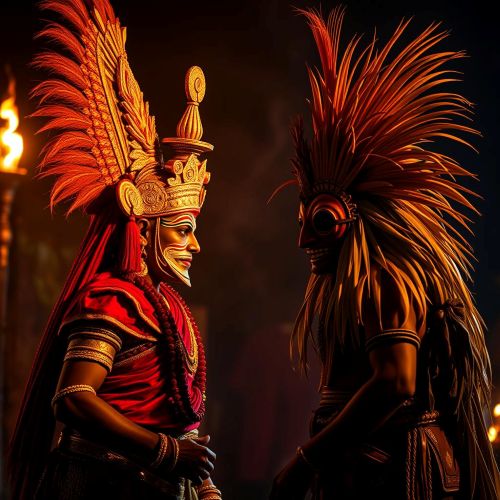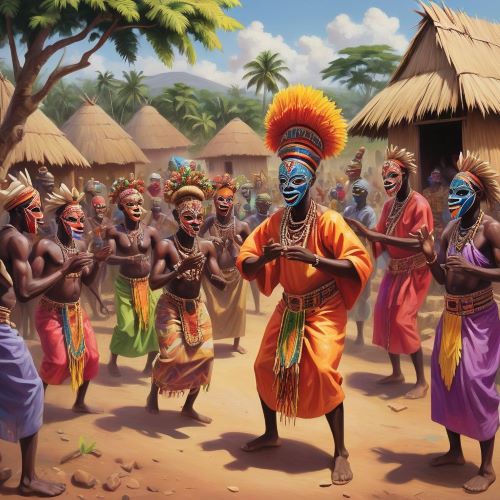Bhuta Kola: Spirit Worship Rituals of Tulu Nadu
Bhuta Kola is one of the most fascinating ritual traditions of South India, deeply rooted in the cultural and spiritual heritage of the Tulu Nadu region of coastal Karnataka and parts of northern Kerala. This ancient form of spirit worship is not just a religious practice but also a socio-cultural event that unites communities, blends folklore with devotion, and serves as a symbolic bridge between the divine, the spirits, and human society.
For the local people, Bhuta Kola is far more than performance art. It is regarded as a sacred duty, a spiritual obligation, and a celebration of ancestral connections. With its elaborate costumes, trance-like performances, and oral storytelling, Bhuta Kola remains one of the most immersive and enduring ritual practices of South India.
Origins of Bhuta Kola
The name Bhuta Kola translates literally to “spirit play” or “spirit performance.” The Bhutas are believed to be guardian spirits, deified ancestors, or divine forces that protect villages, ensure justice, and maintain balance in nature and society. The worship of these spirits predates mainstream Hinduism and finds its roots in ancient animistic traditions of South India.
Over the centuries, Bhuta Kola absorbed influences from Hinduism, folklore, and regional customs, creating a hybrid tradition that still feels uniquely local. Unlike temple-based worship that centers on priests and rituals, Bhuta Kola emphasizes the role of the spirit medium, who acts as a channel between the divine and the human realm.
The Flow of the Ritual
A Bhuta Kola ritual is usually conducted between December and May, aligning with the post-harvest season. The ceremony begins with drumming, chanting, and the recitation of paddanas, oral ballads that recount the spirit’s origin, its powers, and its protective role. These narratives serve as a reminder of the spirit’s connection to the community.
The most striking moment of the ritual is the transformation of the spirit medium. Coming from families that have performed this duty for generations, the medium dons elaborate costumes, face paint, and a towering headdress. As the chanting and drumming intensify, the performer enters a trance-like state, believed to embody the spirit itself.
Once in possession, the medium dances with energy and force, often performing extraordinary feats such as walking through fire or wielding weapons, which demonstrate the spirit’s power. At this point, the spirit is said to communicate directly with the villagers. People approach to seek blessings, ask for guidance, or even present grievances. Through the medium, the Bhuta is believed to deliver justice, resolve disputes, and reassure the community.
The ritual concludes with offerings that may include food, animals (often symbolic), and other sacred items. These offerings are made to appease the spirit and ensure its continued protection. The ceremony often ends with a communal feast, strengthening the sense of unity among villagers.
Costumes and Symbolism
The grandeur of Bhuta Kola lies in its visual and symbolic presentation. The costumes are elaborate, with vibrant face paint, metallic ornaments, flowing skirts, and ornate headdresses that may rise several feet high. Each detail carries meaning. The face paint represents the transformation of the human into the divine. The weapons symbolize protection and justice, while the headdress is seen as a link between the earthly world and higher realms.
This visual spectacle is not just for show – it is a vital part of the ritual that conveys the authority and power of the spirit to the gathered community.
Social and Cultural Significance
Bhuta Kola is deeply tied to the social fabric of Tulu Nadu. It ensures the continued blessings of protective spirits and acts as a system of community justice. Disputes and grievances that may otherwise create conflict are often resolved through the medium, with the spirit’s word considered final.
The ritual also plays an important role in cultural continuity. The paddanas, passed down orally across generations, preserve folklore, history, and moral lessons that might otherwise be lost. The event itself reinforces a collective sense of identity and belonging among the Tulu-speaking people.
Connection with Yakshagana
Bhuta Kola is often compared with Yakshagana, the popular folk theater of Karnataka. Both share similarities in costume, music, and storytelling, but the difference lies in intent. While Yakshagana is primarily a form of entertainment and education, Bhuta Kola is a ritual of possession, justice, and divine communication. The overlap between these two practices highlights the cultural richness of the region and its ability to merge performance with spirituality.
Bhuta Kola in Modern Times
Despite the pressures of modernization, Bhuta Kola continues to thrive in Tulu Nadu. In recent years, the ritual has gained recognition outside the region, especially after the success of the film Kantara (2022), which portrayed elements of Bhuta Kola and brought it into the national and international spotlight.
For the Tuluvas, the ritual remains a cultural identity marker that reminds them of their heritage. While some practices have been adapted to modern sensibilities, the essence of the ritual – spirit worship, justice, and community bonding – remains intact.
Spiritual Symbolism
At its heart, Bhuta Kola is about the eternal relationship between humans, nature, and divine forces. The Bhutas are often believed to embody elements of nature such as rain, wind, and fertility. Honoring these spirits is, therefore, also a way of honoring the natural world. In this sense, Bhuta Kola represents ecological reverence long before the concept became part of modern discourse.
The ritual emphasizes humility and justice, reminding communities that divine forces are beyond human comprehension and must be respected. These timeless values explain why Bhuta Kola continues to hold meaning in an age of rapid change.
Conclusion
Bhuta Kola is more than a ritual – it is a living tradition that merges spirituality, folklore, art, and social justice. Deeply rooted in the soil of Tulu Nadu, it continues to serve as a vibrant expression of cultural identity, reminding communities of the need for harmony between humans, spirits, and the natural world.
To witness Bhuta Kola is to step into a world where faith and folklore meet, where the divine walks among the people, and where cultural pride takes center stage in the form of ritual, dance, and devotion.
No posts were found.









